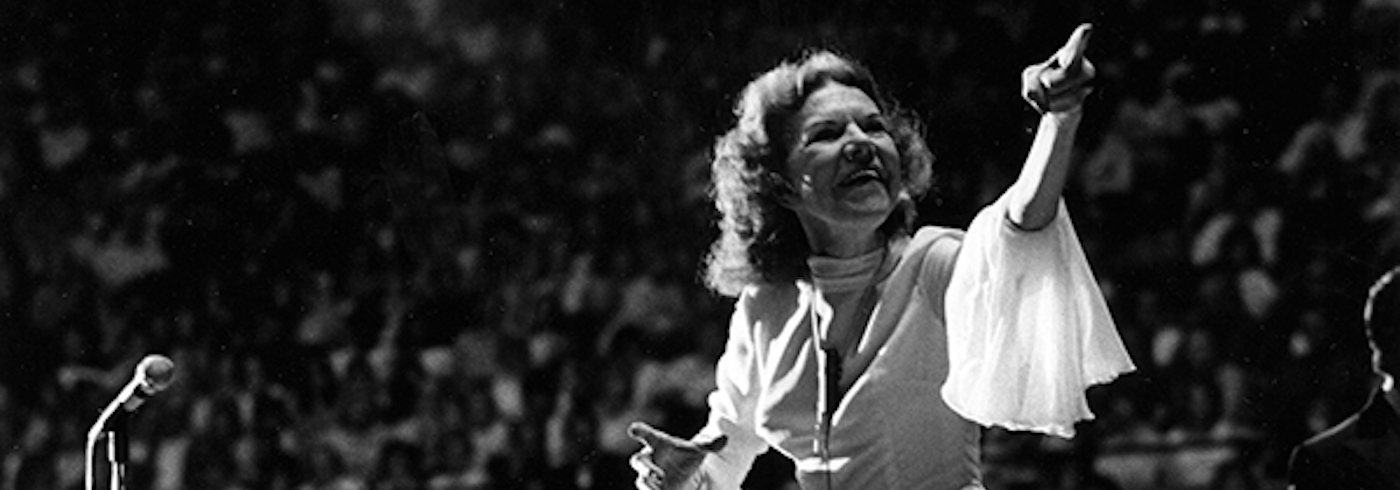The Transformation of Spirit-Filled Christianity
Amy Collier Artman examines the legacy of Kathryn Kuhlman
Readers of a certain age remember Kathryn Kuhlman (1907–76). She was “the miracle lady,” whose catchphrase, “I believe in miracles because I believe in God,” inspired millions to seek faith in Jesus Christ and the life-changing power of the Holy Spirit. The New International Dictionary of Pentecostal and Charismatic Movements even described her as the “world’s most widely known female evangelist.”
Younger readers are likely unfamiliar with Kuhlman, however. Her miracle services, radio ministry, and syndicated television show, though well attended and widely consumed in her day, lost influence after her death. This decline was not unexpected. The ministries of charismatic leaders rarely outlive them, especially when, as in Kuhlman’s case, their estates are diverted away from ministry maintenance toward personal gain by unscrupulous heirs.
And yet, Kathryn Kuhlman should be better known because she played a crucial role in what biographer Amy Collier Artman calls “the gentrification of charismatic Christianity.” Until the middle of the 20th century, classical Pentecostalism was the primary bearer of “Spirit-filled Christianity.” Starting on the wrong side of the tracks, socially and ecclesiastically speaking, classical Pentecostalism had increasingly moved toward respectability by mid-century, as symbolized by the Assemblies of God joining the National Association of Evangelicals as a founding member in the early 1940s. (Today, it is the NAE’s largest denominational member.)
It was charismatic Christianity that accelerated the popularity of Spirit-filled beliefs and practices in the second half of the century, however. Kuhlman was a leader in the transformation of charismatic Christianity from a suspect form of religion to a respectable form of religiosity that was accepted and even celebrated by mainstream Christianity and culture by the end of the 20th century. The Miracle Lady tells the story of how this happened, focusing especially on Kuhlman’s skillful use of talk-show television.
Rather than broadcasting her spiritually charged miracle services themselves, Kuhlman invited people who had been saved, healed and filled with the Spirit to share their own testimonies, first on Your Faith and Mine in the 1950s, then on I Believe in Miracles in the mid-1960s to the mid-’70s. These television shows presented normal looking, intelligent people calmly telling others what God had done for them. Out were the pyrotechnics of the Pentecostal revival service. In were normal folk talking normally about the supernatural.
The Miracle Lady uses Kuhlman’s life as a lens through which to view a crucial period and a key mover in the transformation of charismatic Christianity.
Artman says that Kuhlman and charismatic Christianity “came of age” together. The same could be said of them and television. Kuhlman was an early adopter of the talk-show format, which was perfectly suited for introducing otherwise cautious viewers to charismatic Christianity.
By the same token, Kuhlman in her day made it clear that she was not a “faith healer,” an appellation she shunned. Unlike Word-of-Faith evangelists, she did not believe healing was dependent on the character of one’s faith, or that faith would inoculate a person from suffering. Additionally, she did not use her television show to make continuous appeals for money, despite the high costs of production. (In this respect, she needs to be distinguished from televangelists such as Benny Hinn, who despite implicitly claiming Kuhlman’s “mantle,” never actually met or worked with her.)
Artman also discusses how Kuhlman navigated the tensions of being a woman leader in a theologically and morally conservative movement. Kuhlman adopted a rhetoric of “negation,” often stating that she wasn’t God’s “first choice,” but no man had been willing to step up and do the work, so she volunteered. “Take nothing and use it,” she often said.
Artman contrasts this rhetoric of negation with Adele Carmichael’s rhetoric of “affirmation.” She recounts a 1974 interview Kuhlman conducted with Carmichael on the set of I Believe in Miracles. (Carmichael, five years Kuhlman’s senior, lived until 2003, dying on her way to teach Sunday School at 101 years of age. She continues to hold the record as one of the Assemblies of God’s longest-serving ministers, having been first credentialed in 1918.)
In that episode, Kuhlman remarked to Carmichael, “It was not the easiest thing in the world to be a woman preacher. How did you master it?” Carmichael responded, “I had a wonderful husband who was 100 percent for women preachers. As I study the Word, I believe God needs women, has a place for their ministry.” In fact, she went on, “Many times I’ve prayed thanks that God gave you your ministry and not a man,” Kuhlman demurred, saying “I always thought I was second or third choice.” But Carmichael boldly declared: “I think you were His first choice.”
Even today, unfortunately, Spirit-filled women continue to navigate the difficult waters of leadership, sometimes justifying their ministries through negation rhetoric like Kuhlman’s. Carmichael’s affirmation rhetoric offers a better way forward, it seems to me.
The Miracle Lady is not a who-did-what-when type of biography. If you’re looking for a more traditional biography, I’d recommend Wayne Warner’s excellent Kathryn Kuhlman: The Woman Behind the Miracles. The strength of Artman’s The Miracle Lady is that it uses Kuhlman’s life as a lens through which to view a crucial period and a key mover in the transformation of charismatic Christianity.
A 2008 Barna study estimated that 80 million Americans self-identified as either “Pentecostal” or “charismatic.” This happened, at least in part, because of the efforts of Kathryn Kuhlman to mainstream Spirit-filled Christianity and broaden its appeal. For that, Kuhlman deserves to be remembered.
Book Reviewed
Amy Collier Artman, The Miracle Lady: Kathryn Kuhlman and the Transformation of Charismatic Christianity (Grand Rapids, MI: Eerdmans, 2019).
Photo Credit: Doug Grandstaff Photography
Influence Magazine & The Healthy Church Network
© 2026 Assemblies of God

